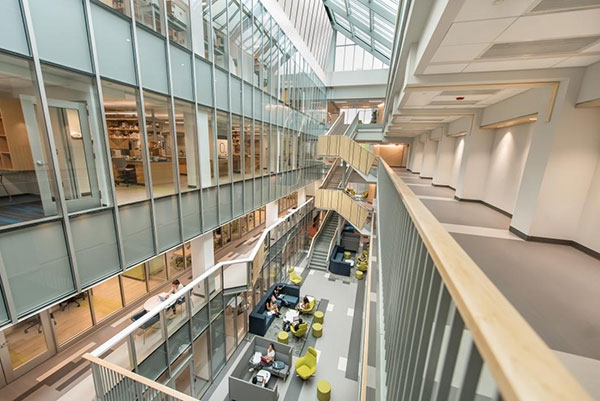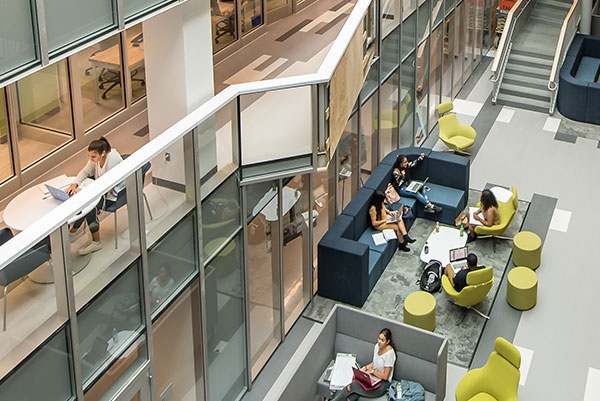When a committee of faculty and administrators gathered more than five years ago to start a conversation over the future of the Science and Engineering Center, they weren’t sure where it would lead.
Built during the late 1960s and dedicated in 1971, the S&E Center had been instrumental in educating generations of students in biology, chemistry, physics and astronomy, and computer, electrical and mechanical engineering.
But it was clearly showing its age.
For inspiration, committee members visited new science buildings at other campuses and worked with architects and stakeholders to design a building that would meet current demands and future needs.
They weighed whether to opt for a completely new complex or a total renovation of the existing building. In the end, they chose a hybrid model. The $100 million project, to be completed in phases, would be the most ambitious and largest in the school’s history.
Since the first part of the striking new glass and steel building opened last month, students and faculty have been effusive in their praise. Transformative. Futuristic. Efficient. Cool.
Known as Stephen Charles Ainlay and Judith Gardner Ainlay Hall in honor of Union’s most recent president and his wife, the space will be formally dedicated Friday, Oct. 12, at 4 p.m. as part of Homecoming and Family Weekend.
Featuring bright, airy classrooms, labs, faculty offices and student study areas, the space is inviting, open and inspiring.
A key feature is a four-story light well in the atrium that promotes visibility and connectedness among disciplines. Designed to showcase the extensive labs and high-level scientific instrumentation not typically found at a liberal arts college, the massive glass panels give students and visitors a clear view of the research taking place.
“A number of schools have new science and engineering facilities but what makes ours unique is that science on display concept,” said Scott Kirkton, an associate professor of biology. He has been intimately involved with the project as both a member of the planning committee and as a faculty trustee.
For example, Kirkton said, a student in an intro science class can look across through all the glass and see upper level students doing research with faculty.
“This allows them to envision making that transition from a student to a collaborator with a faculty researcher.”
In the old S&E, students conducted research in cramped isolated labs separate from classrooms. Also, research typically stopped at the end of the day. The new space is more inviting and engaging, and is intended to be alive after hours.
“By bringing the research space next to the analysis space and allowing free movement between these two spaces without having to leave the relative protection of the laboratory space and entering the common-public space, it’s safer and far more efficient,” said Laurie Tyler, professor of chemistry and chair of the department.
“This allows both the faculty and student researchers to be more productive in their research.”
Tyler is particularly excited about the instrumentation suite, which she compares to those available to students at graduate institutions.
“It’s beautiful,” she said, as she walked through the space surveying students who were busy conducting research. “Our instrumentation is phenomenal. I went to a big school where students didn’t touch instruments like this until their fourth year. Here, it is common for our students all four years. To be able to have it all in this new setting, we’re so lucky.”
Maximillian Tam ’19, a biochemistry major from Queens, said the building’s flow is vastly superior to the old space. He appreciates the proximity of the research labs, writing space and faculty offices.
As a senior, he will be able to enjoy the new space for one year and he plans to make the most of it.
“Ainlay Hall is a great space because it provides a comfortable environment for students,” he said. “Each time I enter the building, I feel like it is a new experience. It offers a lot of creativity and inspiration for me.”
Work has already begun on the next phase of the project, which includes the renovation of three sections of the existing S&E center by fall 2019. Two other sections will be demolished and replaced by an outdoor quad.
When finished, the 142,000-square-foot space will connect directly to the Wold Center, and Bailey, Butterfield and Steinmetz halls. New outdoor walkways, seating areas and expanded green space will improve foot traffic significantly within the integrated science and engineering complex and enhance the campus grounds.
The new space is not only exciting for current students and faculty. It will be a major selling point for prospective students. As the first liberal arts college to offer engineering in 1845, Union holds a distinctive place in higher education. Early admissions tours have been overwhelmingly positive.
“A lot of what we have done here has been designed around Union’s philosophy of how can we inspire the next generation of students and improve our teaching and research capabilities,” Kirkton said. “I think we are doing that.”

